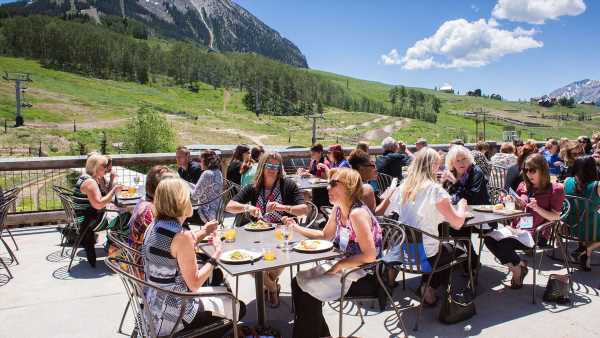
On the heels of a wildly successful winter season, ski-centric mountain properties across the Western U.S. may be seeing a steep slowdown come summer.
A report from Inntopia’s DestiMetrics division, which tracks mountain lodging metrics, warns that “summer alarm bells are ringing” for mountain destinations across Colorado, Utah, California, Nevada, Wyoming, Montana and Idaho.
March data indicates that on-the-books occupancy for the upcoming summer, May through October, is down 13.5% from last year. (Inntopia is owned by Travel Weekly parent Northstar Travel Group.)
And it’s not merely a case of pandemic-related impact skewing the data. Compared with this time in 2019, on-the-books occupancy is down 9.9%, with double-digit declines in the four months from May through August.
Despite the stark drop-off in occupancy, the average daily rate for Western mountain destinations remains exceptionally strong, DestiMetrics found, with ADR up 6.8% from the summer prior and 45.3% compared with summer 2019.
Tom Foley, senior vice president of business intelligence for Inntopia, said the discrepancy between slowing occupancy and sky-high rates means that those mountain resorts may have finally hit the price ceiling, at least when it comes to summer.
“It’s a little upside-down now in that we’re taking more rate than the consumer can give,” Foley said. “The pandemic has basically run its course, but we’ve now switched over to an economic crisis. It isn’t a deep economic crisis, but it’s clearly impacting business, and we should be responding economically.”
We might see rate drops and deals
Foley said he expects to see a mixed response to the slowdown as summer nears. Based on some recent polling, he predicts a minority of mountain lodging operators will opt to hold their rates this summer, while the majority will either start dropping rates or rolling out value-add promotions such as kids-stay-free or a meal or activity inclusion.
“We have been operating with some amount of impunity over the course of the winter, and prior to that, over the course of last summer, because of snow and pent-up demand, respectively,” Foley said. “But it’s a different guest coming for different reasons in the summer, and that summer guest doesn’t have the same financial independence as the winter traveler.”
Willie Fernandez, chief marketing officer for Rental Escapes, a luxury villa rental specialist with inventory in mountain markets in Colorado, Utah, Montana, California and Idaho, also said that mountain destination bookings for summer are softening.
“We are seeing a slowdown” in U.S. mountain destinations over the next few months, Fernandez said, while heightened summer demand has been shifting to Caribbean and European destinations.
Record snowfall means more mud
The record snowfalls that were a late-winter boon for many mountain destinations are also expected to complicate matters this summer. Delayed snowmelt leads to muddy conditions, putting outdoor festivals, concerts and sporting events scheduled for the earlier half of the summer at risk.
“It’s going to be difficult in many destinations, just because it’s going to be pretty muddy,” Foley said. “And we’re hearing about events that are getting canceled or pushed back into July or August. And while those events will then compete with business in those later summer months, and that could be good, you do end up losing out on that early summer season.”
A softer-than-normal summer would mark a setback for the mountain properties that have invested heavily in bolstering their bona fides as year-round attractions.
According to Foley, the pressure on mountain destinations to diversify their business began building after the economic crash of the Great Recession.
“At the time, the mountain travel industry was hanging its coat on a hook supported by three months of revenue in a good ski season and five months of revenue in an excellent ski season,” he said. “But other than that, it really wasn’t generating revenue.”
Vail Resorts was one of the first big ski resort-focused companies to make a high-profile play for summer travelers, debuting its Epic Discovery summer experiences program at its Vail and Heavenly resorts in Colorado and California, respectively, in 2016.
“Vail Resorts really went to work to change the land-use rules around national forest use and what you could or couldn’t do,” said Foley. “And if you look back through the history of a lot of these mountains, it’s around this time that you see the ziplines and canopy tours and coasters start to show up.”
As part of the Epic Discovery initiative, Vail and Heavenly launched a wave of new amenities and activities, including alpine coasters and canopy tours involving networks of ziplines and treetop aerial bridges.
The Epic Discovery platform has since been successfully expanded to other Vail Resorts properties.
- Related: Ski resorts urged to reach out to Gen Z
More recently, Alterra Mountain Co. announced in late March that it plans to further develop its summer offerings with a revamp of Mammoth Mountain’s Woolly’s Adventure Summit mountain coaster in California, the addition of an alpine slide at Colorado’s Winter Park and a new aerial adventure course at Crystal Mountain in Washington state.
“But the setback here is really being driven by economics, not by infrastructure or the ability to now provide for this different sort of summer guest,” Foley said. “It’s more to do with forces that the industry just doesn’t have control over.”
Source: Read Full Article









